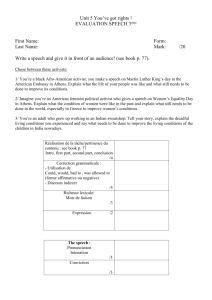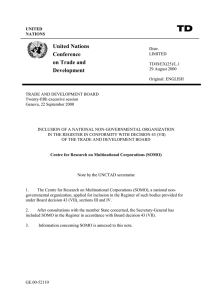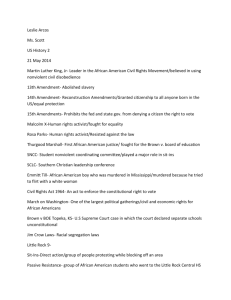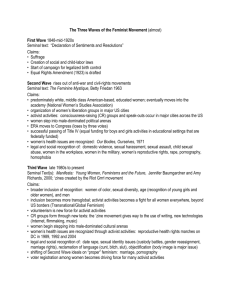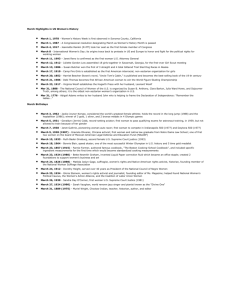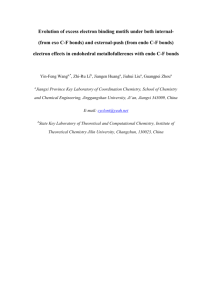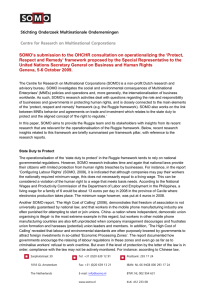Presentation slides
advertisement
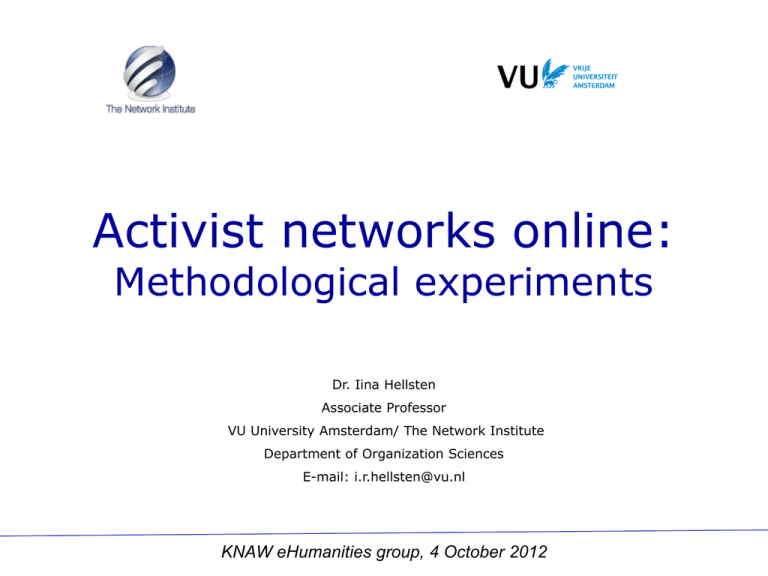
Activist networks online: Methodological experiments Dr. Iina Hellsten Associate Professor VU University Amsterdam/ The Network Institute Department of Organization Sciences E-mail: i.r.hellsten@vu.nl KNAW eHumanities group, 4 October 2012 Online activism http://makeitfair.org/en/take-action Activist groups, campaigns, documents: Methodological challenges Very rich data on activist groups online -- but how to study online activism? Activist Networks Online 2 PARTS: 1) Virtual presence (2010-2011) (de Bakker & Hellsten) * virtual activism? WHO is present? * semantic content? WHAT is communicated? 2) Mapping online activist networks (MONA) (2012-) (De Bakker, Hellsten, Aroyo & Ploeger, Armenta) * tactics and events? HOW are activist networks connected? WHY specific tactics? Part 1: Virtual presence Online visibility: website, links to other websites, use of social media (Twitter, Facebook, blogs) Activist networks and campaigns high visibility on the Web Virtual campaigns? Virtual activism? Virtual presence? internet image by Attila Toro from Fotolia.com Internet and activist networks Think locally, act globally (Castells, 2001) * circulation of material * open forums for activism * linking to other networks and campaigns * raising awareness of the activists’ issues * mobilization Research questions How are activist groups organized online? How are activist networks connected to each other? What do activist networks communicate online? What kind of shared tactics activist networks use online? Methdological challenge: How to map online activist networks? SOMO network * Complex network, “spider in the web” * Coordinates several (changing campaigns) SOMO network * High Web visibility * Coordinating other organizations, networks and campaigns, incl. 8 activist networks “SOMO is an independent, non-profit research and network organisation working on social, ecological and economic issues related to sustainable development. Since 1973, the organisation investigates multinational corporations and the consequences of their activities for people and the environment around the world.” (www.somo.nl) Mixed methods Hyperlink analysis * how do organizations, networks and campaigns link to each other? * IssueCrawler (www.issuecrawler.net) Semantic co-word maps * how do organizations, networks and campaigns frame issues? *automated co-word mapping (www.leydesdorff.net) Simple event model (SEM) * how do organizations, networks share events? Combination of methods allows us to track campaign events and link these to specific activist groups and firms over time and across the networks Three steps, three questions 1. How are organizations, networks and campaigns linked to each other on the Web? 2. How is the structure of organization networks and semantics within the Web site linked to each other? 3. How do the semantics of a network SOMO) and a campaign (e.g. makeITfair) differ from each other? (e.g. Hyperlinks Hyperlink structure of linking organizations, networks and campaigns Issue Crawler www.issuecrawler.net Focus on SOMO as a coordinating network of activist groups and makeITfair as one campaign December 2010, May 2011 and December 2011 Hyperlinks December 2010 Facebook taxjustice makeITfair SOMO goodElectronics Figure 1: Hyperlink network of 52 organiztions around the website of SOMO, 20 December, 2010, [Issue Crawler results, SOMO highlighted, crawl depth 3] Hyperlinks May 2011 SOMO makeITfair OECD watch Facebook goodElectronics SOMO hyperlink network of 52 organizations, 26 May, 2011, [Issue Crawler results, SOMO highlighted, crawl depth 3] Hyperlinks and semantics Structure and content of the networks SOMO website news compared to hyperlinks Focus on January-May 2011 Semantic networks Tools to map co-occurring words in text documents (e.g. news on the web sites of the activist networks) Steps: 1. Download text documents 2. Create a word frequency list and a stop word list 3. Run TI.exe to create asymmetrical worddocument matrices 4. Visualise results with Pajek (source: Loet Leydesdorff, see www.leydesdorff.net) SOMO news, sustainable January-May 2011 labour Apple, report electronics Civil society advocacy market Chinese, factories, pressing, improvement OECD, Watch ethical countrie s African, uranium mining SOMO website news in January to May 2011 (22 documents,123 unique title words occurring twice or more often, cosine>0>0.882) Semantics of SOMO vs. makeITfair Semantics between network and campaign (different tactics, different styles?) SOMO (network) makeITfair (campaign) Focus on website news 2008-2010 SOMO news 2009 Call fair mobile phones electronic new Computer industry labour rights WTO financial crisis European makeITfair EU trade, developing countries SOMO website news in 2009 (47 documents, 39 unique title words used twice or more often, cosine >0>0.481, separate components) SOMO news 2010 OECD guidelines ITfair sustainable sector Global business rules Foxconn suicides new EU financial reform, developing countries SOMO SOMO website news in 2010 (48 documents, 39 unique title words occurring twice or more often, cosine>0> 0,430, separate components) makeITfair 2009 Shenzhen, mobile phone industry IT Nokia free electronic South African prior informed consent makeITfair website news, 2009 (19 news documents, 79 unique title words, cosine >0>0.729 makeITfair 2010 Electronic sector global China appalling fair Mobile phone IT campaig n Foxconn suicide Local voices must heard makeITfair website news, 2010, 10 news documents, 53 unique title words, separate components, cosine >0>0.845. Results (1) Inter-organizational network (hyperlinks) * relatively stable (OECDWatch new comer) * the role of social media (Facebook, Twitter, YouTube) increasing Hyperlinks vs semantics * SOMO news actual topics behind the hyperlinks (campaigns, organizations, other networks) Results (2) Semantics of SOMO vs. makeITfair *different styles (implicit frames) SOMO: neutral, global informative style (reports, standards, particular campaigns) makeITfair: call for action (negative words, threats, risks, alerts) But how to get an idea of the tactics used by activists in online networks? Example of activist events & tactics http://techland.time.com/2012/02/09/foxconn-hacked-asapple-customers-prepare-to-deliver-petitions-calling-forethical-iphone-5/ Example How to automate the analysis of such text documents? Part 2: MONA project MONA (Mapping Online Networks of Activists) KNAW Academy assistant project Goal: event database (incl. tactics) Computer Science Lora Aroyo – Supervisor Thomas Ploeger - Student Social Sciences Bibiana Armenta – Student Frank de Bakker - Supervisor Iina Hellsten - Supervisor Computer & social sciences collaboration Social Science: – How activist networks try to target organizations on issues of (corporate) social responsibility on the Web Computer Science: – How existing data mining, information retrieval, and visualization techniques can be applied to studying activist networks ACTEVE (ACTivist EVEnts) model Determining activist networks Selecting campaigns (that attracted media & web attention) Identifying different events and related tactics (tactics list) Tracing framing of issues GOAL: semi-automated tracking of online activist network events and tactics Campaign and event models Fig. 1. (A): Initial model: Campaign-centered. (B): Revised model: Event-centered Source: Ploeger, T. & Armenta, B, & Aroyo, L. & de Bakker, F. & Hellsten, I. (2012) Making sense of the Arab revolution and Occupy: Visual analytics to understand events, CEUR Workshop Proceedings 902: pp. 61-70. Case study 1: makeITfair campaign Crawling makeITfair site (RapidMiner) http://rapid-i.com/content/view/181/190/ Focussing on single events within the text documents (bottom-up approach) Identifying events and networks of events Visualizing events and tactics with timelines and location maps Example of activist event Example: “Foxconn Hacked as Apple Customers Prepare to Deliver Petitions Calling for ‘ethical ‘iPhone 5” State: Hacked ? Tactics: Hacking, petitions call for Event: petitions Date? deliver Actor 1: Apple customers Company: Foxconn Hacked? Issue: unethical iPhone Is part of Campaign: Ethical iPhone ACTEVE Model Procedure 1(2) Statistics on co-occurring words in full text documents Procedure: 1) Starting from e.g. company names (within 1 event) 2) mapping the verbs that co-occur in the sentence with a company name 3) filtering the most frequent co-occurrences 4) Proceeding to events, issues, tactics etc. Event Model Procedure 2(2) Current state-of-affairs Experimenting with different aggregation levels and stopword lists Time stamp sometimes problematic (several past and future oriented dates in full text) Passive tense in verbs sometimes problematic (Foxconn hacked… does not include who hacked Foxconn) Case study 2 Arab spring and Occupy movement Methodological experiment: Outcomes for Social Sciences Mapping and visualizing single events of activist networks Enabling several perspectives on one event Mixed methods approach: How to combine hyperlink & semantic maps mehtods to Event Model results? Future avenues Integrating the three steps, three methods (into one straight staircase)? Case studies 1) Arab Spring 2) Occupy protest movement 3) Climate change activism networks Thank you! Acknowledgements: VU/ The Network Institute: KNAW Academy Assistant Project More information: Ploeger, T., Armenta, B., Aroyo, L. de Bakker, F. and Hellsten, I. (2012): “Making Sense of the Arab Revolution and Occupy: Visual Analytics to Understand Events”, CEUR Workshop Proceedings, vol. 902, pp. 61-70 (ISSN 1613-0073) http://ceur-ws.org/Vol-902/ de Bakker, Frank & Hellsten Iina & Kok Anne (2011) “Examining Activism: Tracing networks and tactics on CSR” notizie di POLITEIA, XXVII, 103, pp. 66-77. Bakker, de, Frank & Hellsten, I: “Virtual Presence: On Mapping How Activist Group Networks (try to) Impact Firms”, under review
